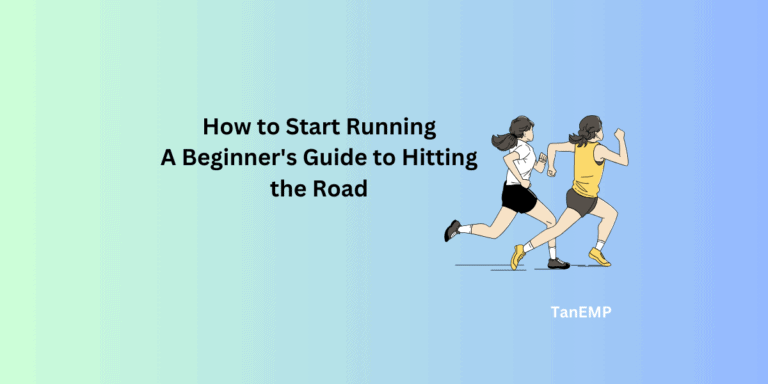19 Tips for Beginner Runners – Get Started on the Right Foot (2025)
Did you know that over 48 million Americans lace up their running shoes in 2023?
Among these 48 million, how many are new to running?
You stumble to this post which means that you’re new to running and looking for tips to start your running journey.
As a chiropractor working with new and elite runners alike, I’ve seen what works best for beginners.
My first piece of advice for someone new to running is just START RUNNING. Many people fail to take the first step because of the fear of not knowing how to run properly.
But before you take your first step outside, spend a few minutes going over our 19 Tips For Beginner Runners. These tips may enhance your running experience.
Ready to take that first step?
Pro Tips for Beginner Runners:
- Don’t skip on warm-up and post-stretch
- Start slow, Don’t run too much and too fast
- Use run walk method
- Remember to hydrate properly
- Add Weight training to improve performance
19 Tips For Beginner Runners
1. Start with the Right Gear
For a new runner, you don’t need top-notch gear to run. I wore my day-to-day shorts and basketball shoes on my first run.
But if you’re serious about running, I recommend you buy affordable running shoes to avoid blisters like I did with my basketball shoes.
For starters, getting the right running shoes, comfortable moisture-wicking clothing, a running watch to track your progress, and a water bottle is a good start.
2. Begin with a Walk-Run Program
I suggest you use the walk-run program for new runners in the 1-3 weeks of running.
This method involves a sequence of walking and running to get your body ready for a longer run.
One of my patients took 4 months off from running, and she was running 3x weekly for 30 minutes each time. It’s no wonder she experienced knee pain after just two weeks.
You don’t want to run too much too fast at the beginning when your body is not ready.
3. Stay Hydrated Throughout Your Run
We can’t stress enough the importance of hydration during your run. Your bodies lose a ton of water when you run, so staying hydrated is crucial.
Drink about 16-20 ounces of water two hours before your run.
During your run, it’s a good idea to carry a water bottle so you can keep hydrated during the run (especially during the summer). Aim for 6-8 ounces every 15-20 minutes.
Watch out for signs of dehydration like dark pee, dizziness, or headaches.
Remember, proper hydration can make all the difference in your running performance and help you avoid injury.
4. Focus on Time, Not Distance
When I started, I was obsessed with miles, but trust me, watching the clock is way better for us beginners. Why?
It helps you build endurance without overdoing it. Start with short runs, maybe 10-15 minutes, and gradually increase your time each week.
Don’t worry about pace or distance. Just keep on running.
This approach lets you listen to your body and progress at your own pace, reducing the risk of injury.
Before you know it, you’ll be running longer and feeling stronger!
5. Prioritize Proper Form
Running is easy, but it is important to run in proper form such as:
- Keep your head up
- Relax your shoulders
- Arms at about 90 degrees
- Land at your mid-foot, not on your heel
- Try to keep your feet under your body
- Avoid overstriding
Following these 6 running tips will help you gain a proper running form.
6. Spend Time on Proper Warm Up and Cool Down
Don’t skip out on your warm-up and cool down. Your body will thank you in the long run by doing so.
Trust me, many of my patients run without doing either. They complain of knees, heels, Achilles, calves, or hip pain after running for a few months.
Proper warm-ups like butt kick, high knees, lunges, or side lunges will get your body ready for your run.
Don’t run home after your run, spend 5-10 minutes stretching your hamstring, calves, hip flexor, and lat muscles. Make sure to breathe through the stretch, it is crucial for your muscle recovery.
Remember, a proper warm-up and cool-down routine is the best injury prevention.
7. Fuel Your Body Right
Running burns a lot of calories. It can burn up to 500 calories in 30 minutes run. So it is crucial to fuel your body properly.
Before a run, grab a banana or some toast with peanut butter for quick energy. After a run, have a mix of protein and carbs to help with recovery.
Don’t forget to stay hydrated! Plain water is great, but for longer runs, you might need something to replenish electrolytes.
Remember, a balanced diet is key to keeping your body happy and injury-free.
8. Pay Attention to What Your Body Tells You
Your body talks to you while running. You just need to learn what your body telling you.
There are two feelings when you run:
- OK feeling: When your muscles feel tired
- Bad feeling: When you feel real pain
Here’s what I learned the hard way: One hot morning, I ignored a pulling pain in my leg while running uphill. I thought it was just the heat. Big mistake! The next day, I couldn’t walk and needed a week to recover.
A little muscle tiredness is fine, but real pain means STOP! Listen to your body to keep running longer.
9. Set Reachable Goals
As a beginner runner, it may be tempting to set huge goals. But setting too big of a goal most likely leads to failure. Instead, set a small reachable goal to celebrate small successes.
Maybe aim to run for 20 minutes without a walk break, or sign up for your first race. Mix short-term goals (run three times this week) with long-term ones (complete a half marathon).
And don’t forget to celebrate those small wins! Every step forward is progress. Remember, realistic goals keep you motivated and help prevent injury. Keep at it!
10. Join a Running Community
Join a local running community has many benefits such as:
- Find a running buddy
- Motivation
- Meet with experienced runners
If you can’t find a local or online community that interests you, create one with a few running buddies at work or friends.
11. Track Your Progress
As someone new to running, you should track your running progress. I used to just wing it, but keeping a running log changed my running journey.
With a running log, you can easily see how’s your progress each week. Easily make adjustments to improve your running.
You can use a running app or good old pen and paper to track your time, distance, and feelings after each run. These records are useful when you’re working with a running coach.
12. Invest in Safety
For runners who run outside, you need to invest in safety. I live in NYC, and running outside can be dangerous because of the cars, bicycles, mopeds, and people.
I always run with my bright colors or reflective gear, especially in low light. Know the road rules and run against traffic.
Don’t forget to mix up your routes for safety (and to beat boredom). Weather can be tricky, so dress in layers.
Hot day? Start slow and hydrate. Cold out? Warm up inside first. Remember, staying safe means you can keep running and crush those fitness goals!
13. Practice Mental Toughness
Building mental strength is crucial for continuous running success.
At first, it’s normal to feel like quitting. Your mind often hits the wall before your body does.
Here’s my top tip: when those tough moments hit, step back your maximum effort instead of stopping completely.
Focus on your breathing and remember why you started. Whether it’s completing your first 5K or improving your health, keep that goal in mind.
Mental resilience grows with every run, just like your physical endurance. A slower pace is better than no pace!
14. Cross-Train for Better Performance
Many running only focus on running, and skip out on strength training. It’s a big mistake.
Cross-training helps prevent injury and boosts your running performance. Mix in some strength training, like squats or lunges, to build those running muscles.
Swimming or cycling are great for cardio without the impact. Yoga can improve flexibility and balance.
Try to cross-train 1-2 times a week. Trust me, your body will thank you, and you’ll see the difference in your running routine. It’s all about staying injury-free so you can run longer and faster.
15. Recovery tools
Muscle soreness and tightness are common in runners. On your rest day, don’t just sit down and do nothing. This will only slow down your muscle recovery.
Your body needs time to repair and get stronger between runs. Recovery tools can make a huge difference.
I treat my foam roller like a personal massage therapist. Compression boots are great for boosting circulation, and a theragun can work wonders on tight muscles.
Don’t have fancy gear? Simple stretching and proper hydration go a long way. Remember, smart recovery leads to better performance.
16. Run Indoor During Extreme Weather
Don’t let nasty weather stop you from running!
While some runners go out in any weather, it’s smart to run inside when it’s unsafe outside. Using a treadmill keeps you safe when it’s too hot, cold, or stormy. You can run at your own speed without worrying about ice or getting too hot.
Not a fan of treadmills? Try finding an indoor track instead!
If you do use a treadmill, here’s a pro tip: Put it on a tiny uphill setting. This makes it feel more like running outside.
17. Concentrate On Your Breathing
Breathing is one of the most crucial elements in running.
When I first started my running journey, I was gasping for air and got really exhausted after a 15-minute run. Then I learned about proper breathing techniques, and my run is smoother and less strain.
Focus on deep belly breathing. You inhale through your nose, let your belly expand, then exhale through your mouth. Try to match your breath to your footsteps.
For example, breathe in for two steps, out for two. This rhythmic breathing can help prevent injury and improve your running form.
Plus, concentrating on your breath is a great way to stay present during your run. Give it a try on your next run!
18. Run In the Morning or Night?
Both morning and night runs have their perks!
Morning runs kickstart your metabolism and boost your energy for the day. Plus, you’re more likely to stick to your running routine when you knock it out early.
Night running can be great for stress relief after work, but remember safety first! Always wear reflective gear, choose well-lit routes, and let someone know your plans.
The best time to run? It’s whenever you’ll consistently show up for it!
19. Add Strength Training
Make sure to add 1-2 days of strength training to your running program. Strength training benefits include increased muscle strength, which helps in running, and injury prevention, which avoids compensating for weak muscles.
Muscles to focus on your training:
- Gluteus
- Hamstring
- Quadriceps
- Hip Flexors
- Rectus Abdomins
- Upper Back
Wrap Up
You’re now armed with 19 powerful tips to kickstart your running journey. Remember, every expert runner was once a beginner just like you.
The key is to start slow, stay consistent, and most importantly enjoy the process.
Running isn’t just about burning calories or hitting milestones. It’s about discovering your strength, both physical and mental.
So lace up those shoes, hit the pavement, and get ready to surprise yourself.
FAQ Tips For New Runners
1. What type of clothing should beginner runners wear?
Wear comfortable, moisture-wicking clothing to keep you dry and prevent chafing. Avoid cotton, as it retains moisture, and consider layers if you’re running in cooler weather.
2. How often should beginner runners run each week?
Beginner runners should aim to run 1-3 times per week, allowing rest days in between. Gradually increase the number of running days as your endurance improves.
3. Should I run on a treadmill or outside as a beginner?
Both options are great for beginners. Treadmills offer more control over pace and weather, while outdoor running provides fresh air and varied terrain. Choose whichever you’re more comfortable with.
4. How fast should I be running as a beginner?
Run at a comfortable pace where you can hold a conversation without being out of breath. Speed will naturally improve over time, but starting slow is essential to avoid burnout.
5. Is it okay to take walking breaks during my run?
Absolutely! The run-walk method is a great way to build endurance for beginners, and taking walking breaks helps prevent overexertion and injury.





